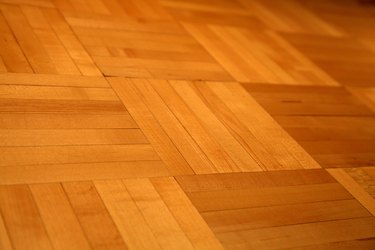
True wooden parquet consists of solid wood pieces. Like any solid wood product, wooden parquet accepts stain and other finish coats. However, some flooring professionals consider parquet a difficult material to finish because the grain of adjacent pieces run in opposing directions, which forces finishers to perform difficult, cross-grain sanding. Despite such a project's difficulty, wooden parquet remain popular and many retailers offer sanded, ready-to-stain parquet flooring. Whether you plan to refinish an existing wooden parquet floor or install a new one, an overview of parquet finishing techniques prepares you to apply an even, attractive stain and finish coat.
Sanding
Video of the Day
Usually expressed as a number, "grit" refers to a sandpaper's relative abrasiveness; small numbers represent rough paper and large numbers represent relatively fine paper. If renovating an existing parquet floor, flooring professionals remove old clear-coats and stain with rough sandpaper, such as 40-grit or less. They apply successively finer grits until the wooden parquets are bare and the floor surface is smooth and even. Flooring professionals typically use heavy-duty, walk-behind floor sanders and specialized edge-sanders. For the do-it-yourself builder, professional-quality floor sanders are widely available for rent at home improvement stores and rental yards.
Video of the Day
Repair and Preparation
During the repair and preparation phase, flooring professionals perform sanding touch-up, particularly in corners inaccessible by machines. If existing parquet floors exhibit nicks, splits or gaps, they fill voids with a wood-filler compound. They ensure that the wood-filler is suitable for staining. After filling voids with wood-filler and trowel, floor installers use a floor buffer to smooth the floor surface and blend the filler with parquets.
Applying Stain and Clear Coat
Although many wood stains are suitable for application with a brush or roller, flooring professionals often apply special "wiping stains" by hand. Although manual application of stain requires more labor than brushing, wiping stains are more viscous than penetrating stains and generally exhibit better coverage and more even color tone. Additionally, the hand-application of wiping stain allows flooring professionals to feel the surface of the parquet flooring as they apply stain. If finishers encounter imperfections or spots missed during sanding and buffing, they repair and sand the unsuitable areas by hand.
Finish Work
To finish a stained parquet floor, floor finishers apply a protective clear-coat over the stain and finish it with a light sanding and buffing. They usually apply the clear-coat with specialized, squeegee-like tools, called "floor coaters." After clear-coat cures, finishers lightly sand and buff the floor, clean the floor surface and apply additional layers of clear-coat. Parquet floors often have two to three layers of clear-coat.